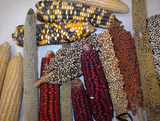

Background
 The Genebank of Zimbabwe (GBZ), also known as the National Plant Genetic Resources Centre (NPGRC) is a center for research and conservation of plant genetic resources in Zimbabwe. The NPGRC is under the auspices of the National Plant Genetic Resources Committee (NPGRCom.), a board that coordinates and oversees the promotion of activities associated with plant genetic resources in the country.
The Genebank of Zimbabwe (GBZ), also known as the National Plant Genetic Resources Centre (NPGRC) is a center for research and conservation of plant genetic resources in Zimbabwe. The NPGRC is under the auspices of the National Plant Genetic Resources Committee (NPGRCom.), a board that coordinates and oversees the promotion of activities associated with plant genetic resources in the country.
Objectives
The main objective or mandate of the GBZ is to carry out activities that are aimed at promoting the conservation and sustainable utilization of plant genetic resources for food and agriculture. Specific objectives include:
- To undertake collection missions for indigenous plant genetic resources important for food and agriculture;
- To document indigenous knowledge systems (IKS) on plant genetic resources important for food and agriculture
- To multiply and regenerate plant genetic resources;
- To characterize and evaluate plant genetic resources;
- To undertake awareness campaigns and farmer trainings on the value of plant genetic resources conservation and sustainable utilisation;
- To conserve germplasm in the National ex-situ genebank;
- To undertake on-farm/in-situ research and promote onfarm conservation;
- To facilitate dissemination of information and the distribution of material for different utilisation purposes.
Activities
Collaboration
- Collaboration with Community Technology Development Trust (CTDT) on the implementation of the project on Evaluation of best practices for landrace conservation: farmer evaluation in Tsholotsho and Murehwa Districts, Bioversity SSA as the regional coordinator, and GEF-UNDP as the financing organizations;
- Collaboration with Bioversity Rome on the project Role of Community Seed Bank in securing diversity on farm- experiences from Zimbabwe on research matters and funding mechanism;
- Collaboration with ICRAF and University of Zimbabwe, Tropical Resource Ecology Unit on the project Evaluation of best practices for indigenous fruit trees conservation in Murehwa District;
- Collaboration with CIMMYT on Morphological and Molecular Characterisation of maize landraces in Zimbabwe.
Achievements
- Facilitated the ratification of the International Treaty on Plant Genetic Resources for Food and Agriculture (ITPGRFA) on 24th March 2004;
- Public awareness campaigns inform of both radio and Television programmes on agrobiodiversity conservation organized under the National Biodiversity Forum;
- Contributed to a number of publications.
Currently Runnings Projects
- Evaluation of best practices for landrace conservation: farmer evaluation in Tsholotsho and Murehwa Districts;
- Evaluation of best practices for vegetatively propagated plants conservation on farm in Makoni District;
- Role of Community Seed Bank in securing diversity on farm- experiences from Zimbabwe;
- Evaluation of best practices for indigenous fruit trees conservation in Murehwa District;
- Multiplication and Morphological Characterisation of maize landraces.
Material
Collections

Representative seed samples of indigenous species of importance in food and agriculture in Zimbabwe are collected from farmers, genetic reserves or any other donor. The collection exercises also target populations of introduced species that have been in Zimbabwe long enough to have developed unique adaptive features. High priority for germplasm collection is accorded to species under immediate threat.
Multiplication
Characterisation
Publications
Distribution of Material
Organisation
National Plant Genetic Resources Committee (NPGRCom)
|
DrCames Mguni |
Chairperson |
Director, DAR4D, Crops |
|
Mr B. Makodza |
Vice Chairperson |
Director, DLPD-AGRITEX |
|
Mr A. Mafa |
Exec. Member |
National Biotechnology Authority |
|
Mr P. Kasasa |
Member |
CTDT |
|
Dr D. Garwe |
Member |
Tobacco Research Board |
|
Dr E. Nengomasha |
Member |
Director, DAR4D, Animals |
|
Mr C. Musvosvi |
Member |
University of Zimbawe |
|
Dr C. Mujaju |
Member |
Seed Services |
|
Mr G. Manokore |
Member |
Zimbabwe Farmers' Union |
|
Mr T. Kamunhukamwe |
Member |
SIRDC: Biotech. Research Inst. |
|
Mr D. Mangemba |
Member |
|
|
Ms N. Nobanda |
Member |
|
|
Mr K. Kwazira |
Member |
|
|
Mr C. B. Richards |
Member |
|
|
Mr K. Kusena |
Secretary |
Curator, GR & Biotech |
Staff
| Mr K. Kusena | Curator |
|
Mrs R. Musango |
Research Technician |
|
Mr O. Chipfunde |
Research Officer |
|
Mr D. M. Mutigwa |
Research Officer |
|
Ms C. Boba |
Secretary |
|
Miss M. Chiwire |
General Hand |
|
Mr P. Kucheva |
General Hand |
Contacts
NPGRC of Zimbabwe
P O Box CY 550, Causeway,
HARARE Zimbabwe
Tel: 263 4 702519, Fax: 263 4 731133
Email: This email address is being protected from spambots. You need JavaScript enabled to view it. or This email address is being protected from spambots. You need JavaScript enabled to view it. (Curator - Mr Kudzai Kusena)

